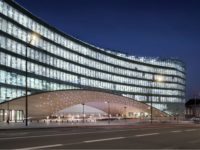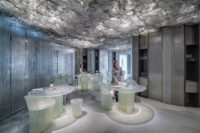Boa Nova Restaurant and Teahouse
Time Machine: A Pritzker Prize winner turns back the clock, restoring one of his first works of architecture after it had fallen into disrepair.






















Architects & Firms
Leça da Palmeira, Portugal
'lvaro Siza's restoration of his first building, the Boa Nova Restaurant and Teahouse, five decades after it opened in 1963, is the happy ending to what could have been an architectural tragedy. The casual pavilion, snuggled into a rocky promontory on Portugal's Atlantic coast, in the town of Le'a da Palmeira, 6 miles north of Porto, was left empty by its municipal owners in 2011 and vandalized by thieves, who ripped out copper gutters and wiring for salvage, destroyed the roof and interiors, and left the structure open to the elements.
Boa Nova marked a turning point in the rebirth of Portuguese modernism during the waning years of the Salazar dictatorship (1932'74), which had isolated the country for decades. With its low tiled roofs and deep eaves hovering over the rocks, counterbalanced by irregular, whitewashed vertical volumes rising to form a chimney and a light scoop, the building mixes elements from Portuguese vernacular architecture with influences from Scandinavia, Frank Lloyd Wright, and Japan. Siza was just a student at the time and under the supervision of Fernando T'vora, his teacher at the University of Porto, who exposed the young architect to such international references. Siza began the project with four fellow students, but his scheme won out over the others.
As young architects do, Siza put everything he could find from this new world of references into the design. He recalls, for example, buying a magazine featuring Alvar Aalto's work. 'I didn't have the least idea who he was, but I thought it was marvelous. In Boa Nova, the influence of his Maison Carr' is very clear,' says Siza.
Now 81, Siza brought to the restoration an authenticity and continuity with the original project that would be difficult for anyone else to achieve. He restored the original wood windows, for example, including their single-pane glazing, something a contemporary firm might not have contemplated. Equipped with new motors, the floor-to-ceiling windows in the dining room can once again retract into the floor, merging the space with the adjacent terrace, a detail he picked up from Mies van der Rohe's 1930 Tugendhat House in what was then Czechoslovakia.
The original woodwork and furniture was made with afzelia, a reddish tropical hardwood from Angola (then a Portuguese colony) that was cheap and abundant at the time, but is expensive and difficult to find now. Siza considered the original tables, chairs, and serving carts to be beyond repair, but he found a carpenter with a stock of old wood to remake them, as well as the table lamps with shades made from translucent wood veneer. To treat water stains on the ceilings, he explains, 'an old furniture restorer treated the wood with something, and it doesn't look too bad.' He removed varnish applied in an earlier restoration to the exterior carpentry and treated the wood with oils, giving it a weathered look. As a result, though the building has been thoroughly restored, equipped with modern mechanical services, and brought up to code, one can still sense its time and age. The only elements that are jarring are the new roof tiles, which had to be specially made to match the originals, but lack the patina of seaside exposure.
The project's conversion into a luxury, reservations-only restaurant is a sore point for Siza, as local residents can no longer come simply to drink a coffee or a glass of wine, and architecture students and aficionados find it more difficult to drop by. Visits can be arranged through the Casa da Arquitectura, which is negotiating with Paula for greater access. Siza complains, 'Only rich people can go there. It wasn't a luxury restaurant before. It was built using good materials, but it was very popular. The other day, they even turned away Rafael Moneo!'
Indeed, the accessible, small-scale gentility of the building belongs to a different age, when a concessionaire could make a living serving tea and snacks on a rocky shoreline beside the ocean, in a country suspended in time. Today, a visit to that once-isolated world is reserved for only a few, it seems. As Siza points out, 'The building's use has changed more than its form.'
PeopleArchitect: 'Ivaro Siza Vieira Designer
Client:
Owner:
Architect
Restoration (in 1991):
Restoration (2012-2014):
Consultants (2012-2014)
Plumbing:
Electrical:
Mechanical Engineers: Lúcios (2013-2014) Size: 5,250 square feet Completion date: July 2014 |
Products
Furniture:
Roof Tiles:
Kitchen equipment: |


